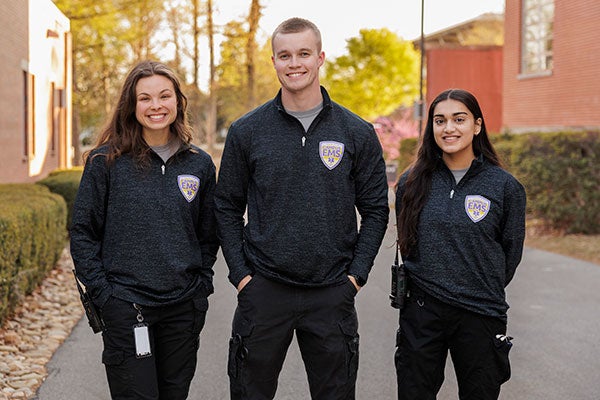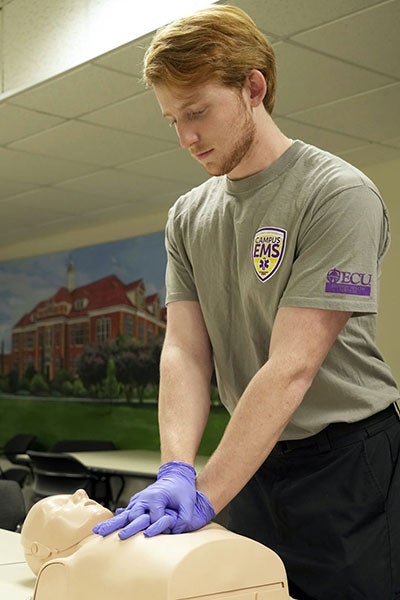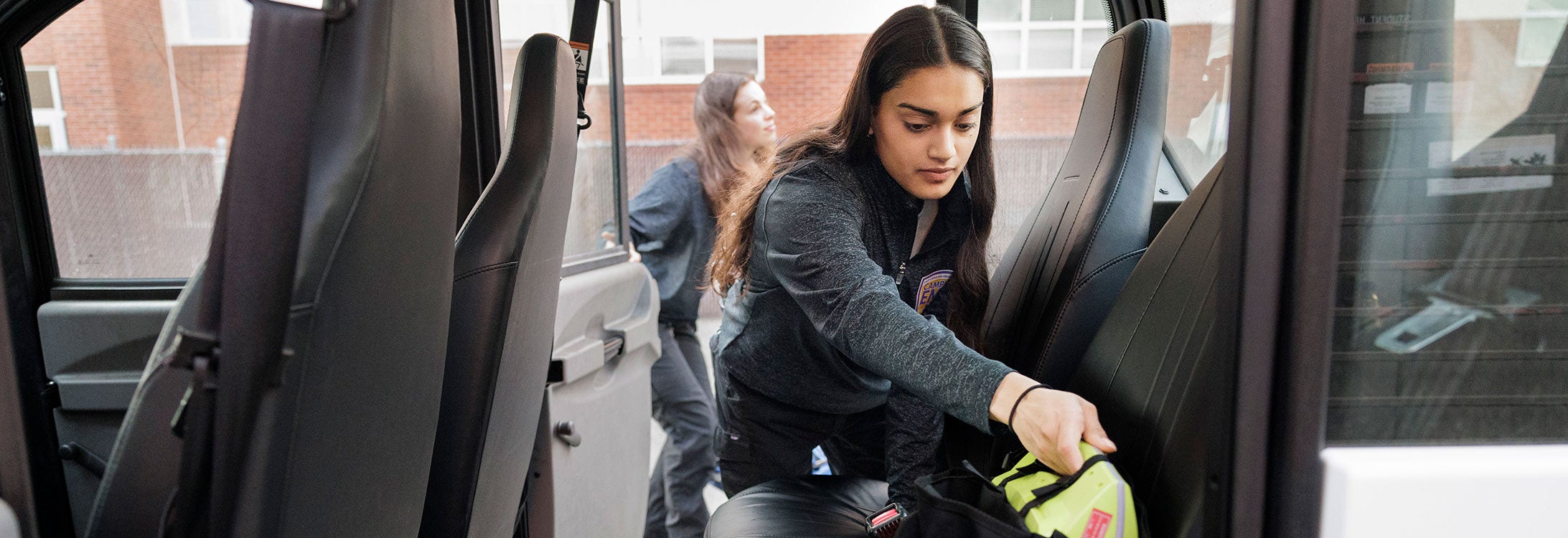Student-led EMS team enhances campus emergency response
Less than five-minute response time. That was one of the first inspirations behind Campus Emergency Medical Services (EMS), a new first responder agency at East Carolina University.
“I started working EMS in college in eastern North Carolina and realized there is a disparity for students to get involved in EMS around this area,” said Alex Fisher, an Honors College student majoring in biochemistry.

From left, EMTs Josie Smith, Alex Fisher and Diya Thaker are part of the Campus EMS team who respond to emergency calls on ECU’s campus Thursday, Friday and Saturday nights during the fall and spring semester.
Fisher grew up in a family of first responders and knew the benefits that Campus EMS could provide like lower response times, especially on weekends. He and fellow Honors College student Matthew Geib, a biochemistry major, created a solid plan and implementation strategy with the help of a working relationship with UNC Chapel Hill Campus EMS.
Creating an EMS unit on ECU’s campus has been an idea brought forward multiple times over the years, according to Ellen Goldberg, associate director for clinical operations in Student Health Services. While past pitches were missing vital elements, Fisher and Geib’s pitch in fall 2023 to Goldberg and Dr. Lanika Wright, the associate vice chancellor of health and well-being, was completely different.
“They had already done a lot of the research into it and had made connections,” Goldberg said. “They had thought about the continuity and the sustainability of the program.”
Student Health Services is the sponsor group where Campus EMS is housed and worked with the student founders to make connections and facilitate meetings with relevant agencies during the planning and implementation process.
As Fisher and Geib gained traction and realized that their pitch was going to become a reality, they began looking for others to add to the team. Honors College students Sarayu Adala and Josie Smith stood out due to their unique skill sets.
“Sarayu is very good at doing a lot of the marketing and social media as well as the training,” Fisher said. “Josie is very good with the logistics and getting things off the ground.”
All their hard work came to fruition in mid-March when they responded to emergency calls for the first time.

Campus EMS EMT Eli Gardner practices CPR on one of the CPR simulator manikins in Student Health Services. (contributed photo)
“We responded to three calls that weekend on campus,” Fisher said. “Getting to see it unfold and us arriving on scene prior to GFR getting there — a couple of minutes prior — and actually helping patients was probably the most rewarding thing. We now know that we can function as our own entity and the hard work we’ve been putting in actually worked.”
Campus EMS offers basic life support services with the goal of providing quick care until Greenville Fire/Rescue arrives. These services can include taking vitals, doing an initial assessment, giving emergency medications, performing CPR and using an automated external defibrillator (AED). In addition to providing 911 response on campus, they have been on medical standby at on-campus events, provided campus emergency education to faculty and students and offered clinical support to Student Health Services.
Looking back, Fisher and Goldberg were both amazed at how smoothly the process unfolded. Between the financial component and the necessary agreements with the university, Greenville Fire/Rescue, Pitt County EMS, the medical director’s office and more, one single rejection could have derailed the entire plan.
“Once we got the university on board, their support really pushed us over anything and that’s a credit to the university,” Fisher said. “There’s also credit to the other organizations. Greenville Fire/Rescue, from the get-go, was very supportive.”
One of the potential hurdles was the dispatch radio system for emergency calls. However, Greenville Fire/Rescue generously offered extra radios. Goldberg noted that the entire community has been extremely supportive, and a future initiative would be finding ways to pay that support back.
“I really think the big goal is getting this off the ground in a really high-quality way and then, once we do that, looking around and saying where else can we get involved,” Goldberg said. “We’ve had some really good partnerships, and I think those will continue to expand as we go.”
For the student EMTs, the benefits are immeasurable — improving communication skills, learning how to talk to patients in emergency scenarios and building clinical skills for future careers in the healthcare industry.
While Fisher, Geib and Adala are graduating this spring, a plan has already been developed for the continuity of Campus EMS. Smith, a current second-year student will be chief next year. Her plans include continuing to prioritize fast, efficient and empathetic patient care.
“What I didn’t realize going into Campus EMS was the level of empathy we’re able to have with the students,” she said. “We know what it’s like to be away from our family for the first time. We know what it’s like to struggle and make friends in that first new season. We know what it’s like to be overwhelmed with the amount of new experiences as a freshman or even feeling a little lost as an upperclassman. So, we’re able to relate to those patients.”
The group was able to hire four EMTs in the fall and just finished their spring hiring process to have a full roster going into the 2025-26 academic year. Smith sees a leadership opportunity for these students and for Campus EMS to be a point of pride for the university.
“I want Campus EMS to be a part of the university that other students are proud of,” she said. “I want them to feel safe on campus, but also think that my university actually cares enough about my health and wellness that they invested into this EMS program so that if the worst thing were to happen to me on a Friday night, I know that someone would be there as quickly as possible.”
